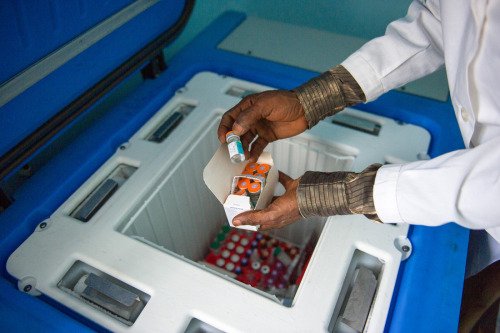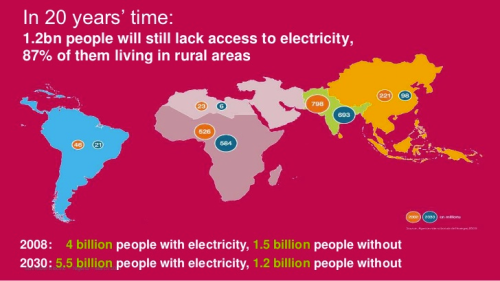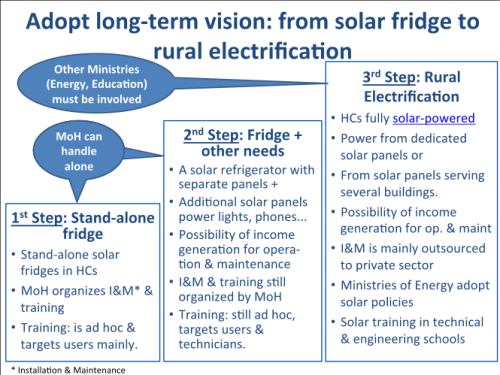Modules and systems (lighting, battery-charging and pumping systems) that use solar power can now be seen on sale in every market and in use in households and fields across developing countries just as any other common consumer goods. So it is very surprising to see how much policy and decision-makers of the energy sector in the developing world continue to think about solar energy like grandfathers!
I am now a grandfather, but in the 80s I was a young civil servant working in a research laboratory in Bamako, Mali. Solar panels were then very costly. Since then, more than 40-fold decrease in cost occurred! Yet policy and decision makers continue to think solar is too expensive as I used to do in the 80s.
The first solar refrigerators that we received for testing in Bamako came from NASA: solar refrigeration was really “rocket science”!
 An example of a modern solar fridge used for vaccines in DRC.
An example of a modern solar fridge used for vaccines in DRC.
At that time, the Expanded Program on Immunization (EPI) was the only health program that reached out to populations in the most remote rural areas – those that typically lack grid electricity. Vaccines were the health products “par excellence” which needed refrigeration. Therefore, it was decided to use solar refrigerators for vaccine storage only. Rules were enacted to prevent storing other products in refrigerators and using electricity from their batteries for other purposes. Batteries were the “weakest link” of the first generation solar refrigeration systems. This led to the development of solar direct drive refrigerators (without batteries). This new development put an end to all possibilities of energy diversion to power other needs.
However, refrigeration is not the only energy need in a health centre. Other important needs are also present such as: lighting, communication (charging cellphones and/or computers/tablets, or powering radio links), small biomedical equipment and water pumping. The installation of a solar refrigerator in a health centre can and should be used as an entry point for the electrification of the health centre and later on of the entire village (figure 1).

Solar energy is now technologically mature, economically efficient in most cases and commercially available. But policy and decision makers in the developing world still have a grandfather’s mentality about it. And the result is so detrimental: today about 1.5 billion people still lack electricity in the developing world and, if people don’t stop thinking like grandfathers about solar, there will still be 1.2 billion people without electricity in 20 years from now (figure 1)!

Solar can do so much more than keep vaccines cool. Solar refrigeration must be considered as an entry point to powering all other energy need of health facilities, including lighting an communication, and seen as a step toward electrification of entire villages (figure 2). When we adopt such a view, we shall go beyond our usual silo and comfort zone to reach out to other stakeholders, including the most important ones: communities!
Written by Modibo Dicko